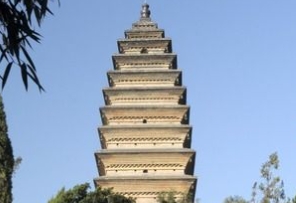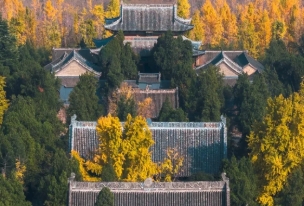The White Horse Temple in Luoyang, established in 68 AD during the Eastern Han Dynasty, is China's first officially built Buddhist temple and is revered as the "Cradle of Buddhism." This ancient temple, standing for over a millennium, marks the beginning of Buddhism's introduction to China and symbolizes the profound integration of Chinese culture and Buddhist traditions.
The temple's architecture, blending styles from the Han, Tang, Song, Yuan, Ming, and Qing dynasties, is a treasure trove of ancient architectural artistry. The grand Mahavira Hall houses solemn and majestic Buddha statues, while the serene Clear Cool Terrace offers a tranquil retreat for meditation. Every detail reflects the ingenuity and artistic mastery of ancient craftsmen.
The White Horse Temple stands as a crown jewel of Chinese Buddhist culture and a global sanctuary of multicultural harmony. Its unique collection of Indian, Myanmar, and Thai-style temples showcases the beautiful diversity of Buddhist traditions. The exotic architecture blends seamlessly with traditional Chinese structures, offering visitors a visually stunning and culturally enriching experience.
Whether you're a devout pilgrim or a seeker of inner peace, the temple provides the perfect spiritual retreat. Here, you can light incense and make a wish, or simply sit in quiet contemplation, absorbing the temple's profound serenity. With its unique charm, the White Horse Temple provides comfort and inspiration to every visitor.
Opening Hours:
Summer (April 1 - October 7): 7:40 AM - 6:00 PM
Winter (October 8 - March 31): 8:00 AM - 5:00 PM
Visiting Route:
Mountain Gate—Hall of the Heavenly Kings—Great Buddha Hall—Mahavira Hall—Reception Hall—Clear Cool Terrace—Scripture Depository—Teahouse—Foreign Temple Complex—Qiyun Pagoda
Official phone number: 0379-63789090
Must-see Highlights
Mahavira Hall
The Mahavira Hall is the heart of the White Horse Temple, originally constructed in the Tang Dynasty and subsequently renovated multiple times. Within its walls, three majestic Buddha statues - Sakyamuni, Bhaisajyaguru, and Amitabha - command reverence with their imposing presence. The hall’s roof, with its upturned eaves and exquisitely carved and painted beams, showcases the superb craftsmanship of ancient architecture. Whether you are here to admire the architectural artistry or to experience Buddhist culture, the Mahavira Hall is a must-see destination.
Clear Cool Terrace
Nestled in the serene backyard of the White Horse Temple lies the Clear Cool Terrace, a tranquil haven where Emperor Ming of the Han Dynasty is said to have retreated for summer respite and scholarly pursuits. This secluded spot, embraced by towering trees and lush greenery, exudes an air of refined elegance. Atop the terrace stands a quaint pavilion, offering visitors a peaceful retreat. From this vantage point, one can gaze upon the temple's architectural wonders, immersing in the profound sense of history and the soothing embrace of nature.
Qiyun Pagoda
Standing outside the White Horse Temple's main gate, the Qiyun Pagoda dates back to the Eastern Han Dynasty, ranking among China's oldest multi-eaved brick pagodas. This 25-meter architectural marvel soars through 13 intricately designed levels, each adorned with unique decorative patterns. From its summit, visitors are rewarded with breathtaking panoramic views of Luoyang, creating a truly uplifting experience. Its shadow dances with the temple's ancient structures, composing a picturesque scene of timeless beauty.
Foreign Temple Complex
The Foreign Temple Complex, a recent addition to the White Horse Temple, offers a captivating journey through Buddhist architecture from across Asia. This unique complex features temples in distinct national styles: the Indian temple, modeled after the Great Stupa of Sanchi; the resplendent golden Myanmar temple; and the exotic Thai-style temple. These architectural marvels not only showcase Buddhism's evolution as it spread across different cultures but also create a visual feast for visitors.
Scripture Depository
The Scripture Depository stands as a treasure trove of Buddhist wisdom, housing an invaluable collection of sacred texts, Buddha statues, and religious artifacts. These precious relics not only document Buddhism's historical journey in China but also reflect the profound wisdom and exquisite craftsmanship of ancient monks. Visitors are granted a rare opportunity to witness the rich tapestry of Buddhist culture up close, experiencing the enduring allure of this ancient temple.


Things to Do
Embrace Zen through Morning Bells and Evening Drums
The melodic morning bells herald a day of tranquility, while the resonant evening drums mark a peaceful retreat from worldly cares. Visitors can immerse themselves in these ancient rituals, finding inner peace through the temple's sacred sounds.
Light Incense, Make a Wish
Before the Mahavira Hall, visitors can light incense sticks and offer heartfelt prayers. Whether seeking health, success, or family harmony, this sacred space provides spiritual solace for all aspirations.
Circumambulate the Pagoda
Join devotees in the meditative practice of pagoda circumambulation. Walk clockwise around Qiyun Pagoda three or seven times, silently contemplating your wishes. This ancient ritual offers both spiritual solemnity and physical relaxation.
Capture Cultural Splendor
The International Temple Area, with its vibrant Indian, Myanmar, and Thai-style architecture, presents a photographer's paradise. From casual snapshots to professional compositions, every corner offers Instagram-worthy moments.
-
Dive into Buddhist Culture
Participate in the temple's cultural programs, from scripture copying to meditation and tea ceremonies. These immersive experiences not only deepen understanding of Buddhist traditions but also provide a serene escape from modern life's hustle and bustle.
Best Time to Visit White Horse Temple
The ideal times to visit the White Horse Temple are spring (March to May) and autumn (September to November).
In spring, the temple comes alive with blooming flowers, particularly during the peony season in April when Luoyang earns its title as the "City of Peonies." The vibrant blossoms against the ancient architecture create picturesque scenes, complemented by mild temperatures perfect for exploration and photography.
Autumn brings cool and comfortable weather, with the temple's ancient trees adorned in red foliage, adding poetic charm to this thousand-year-old sanctuary. The fewer crowds during this season allow for a more contemplative experience of the temple's rich history and Buddhist heritage.
While summer offers lush greenery, the heat can be intense, requiring precautions against sunstroke. Winter, though chilly, transforms the temple into a serene wonderland when blanketed in snow, revealing a different kind of beauty.

Transportation Guide
From Luoyang Railway Station:
Take Bus 56 directly to the temple (terminal station), approximately 40 minutes.From Longmen High-Speed Rail Station:
Take Bus 65 to Guanlin Market, then transfer to Bus 58 to the temple.Alternative Bus Routes:
Buses 87 and 801 also stop near the temple. Choose the most convenient route based on your starting point.Within the Temple:
Explore on foot or opt for the electric shuttle service available within the grounds.
Travel Tips
During holidays (e.g., Spring Festival, National Day), the temple may adjust opening hours or implement visitor limits. We recommend booking tickets in advance through the official WeChat account "Luoyang White Horse Temple" to ensure smooth entry.
-
Comfortable footwear is essential as the temple grounds require considerable walking. Opt for supportive sneakers or walking shoes.
Note:
As a sacred Buddhist site, visitors should dress modestly, avoiding revealing clothing.
Maintain silence in the halls, and refrain from touching statues or religious artifacts.
Photography restrictions apply in certain areas, particularly near Buddha statues and cultural relics. Observe all signage, respect the rules, and avoid using flash photography.




































